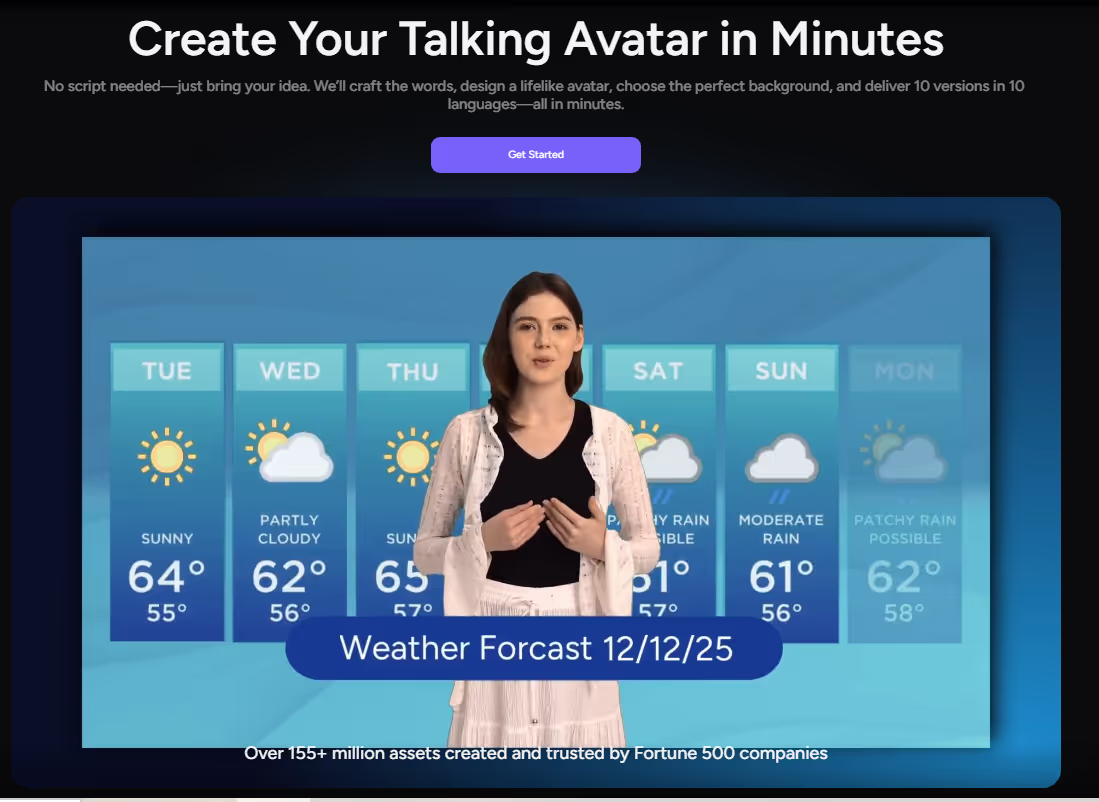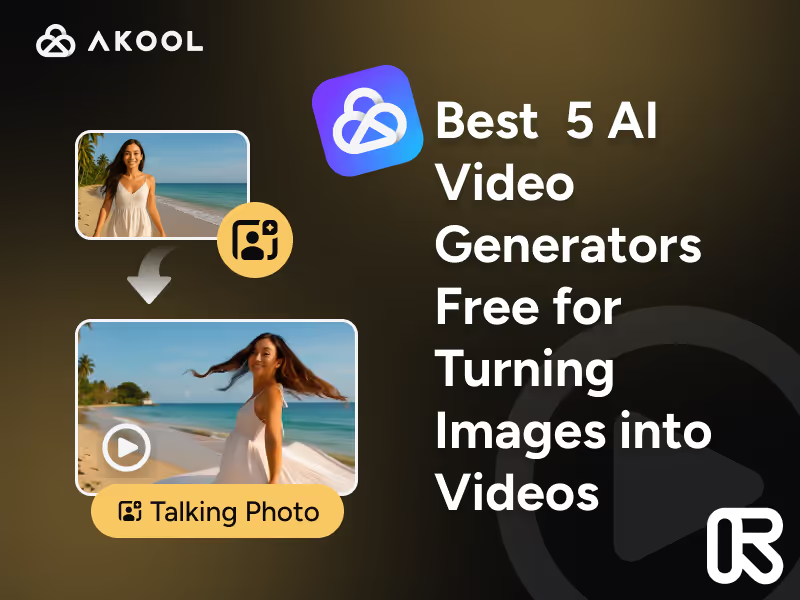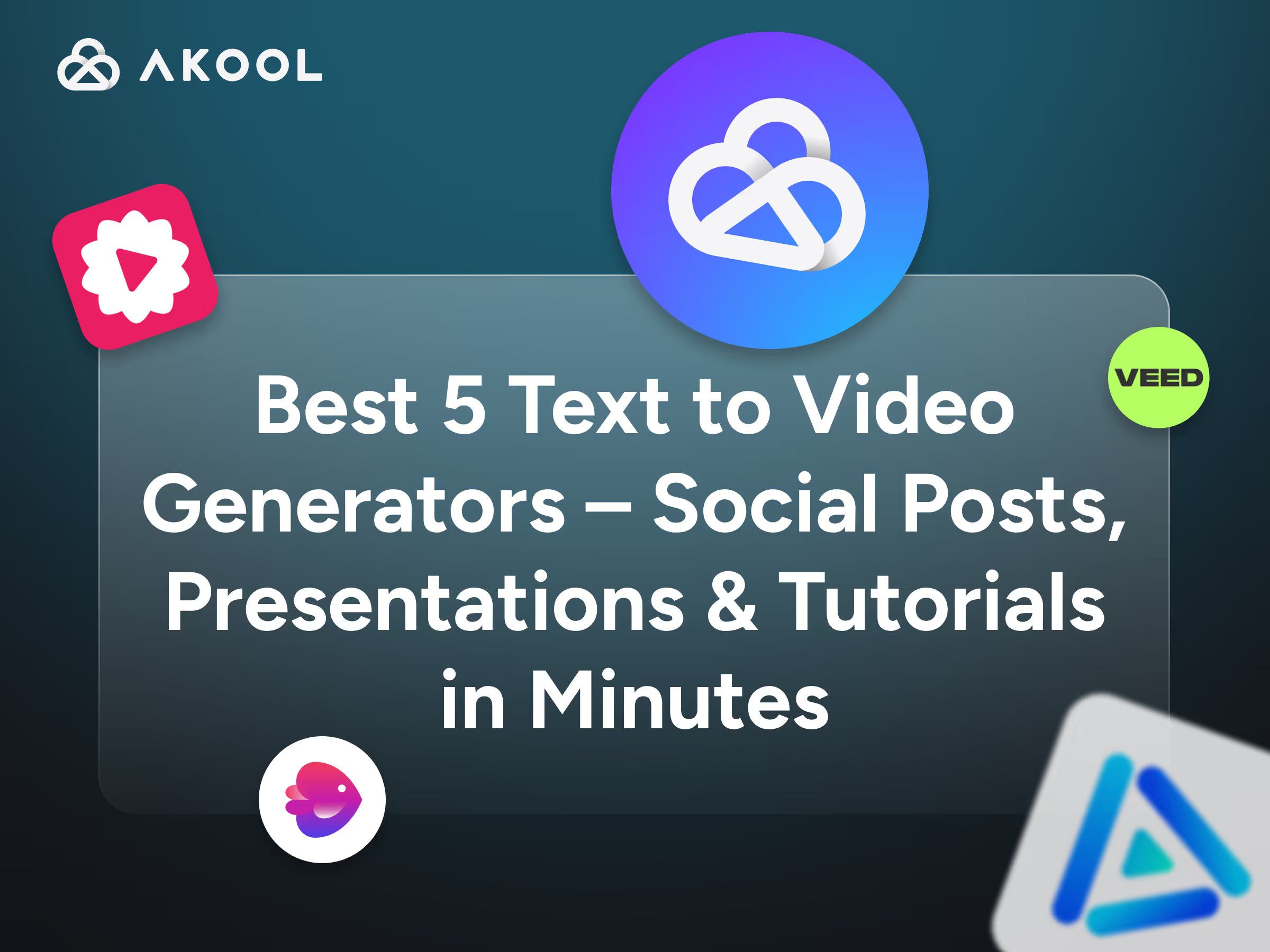Streaming avatar platforms are rapidly changing AI video creation by allowing anyone to generate AI video content with lifelike virtual presenters. These tools convert your script or audio into a talking digital avatar on screen – no camera or actor needed. From educators creating interactive lessons to marketers producing engaging webinars, streaming avatars make it easy to captivate audiences with AI-driven characters. Best of all, many platforms offer a free trial or free plan so you can explore avatar-based video creation at no cost.In this article, we’ll break down five of the top tools leading the charge: Akool, Vidnoz, D-ID, Synthesia, and VEED. We’ll dive into five top options and highlight their features, use cases, and limitations to help you find the perfect fit.
1. Akool — Real-Time Streaming Avatars for Interactive Videos
Akool leads the pack in the real-time streaming avatar space. It’s an AI-powered platform that lets you generate AI video content with digital presenters who can interact live in real time. Akool’s avatars offer impressive realism – think nuanced facial expressions, gestures, and accurate lip-sync across multiple languages. What makes Akool shine is its interactivity and customizability: you can even create a digital twin avatar of yourself or other unique characters to present on your behalf.

Key Features:
- Real-time avatars with lifelike expression: Stream live-speaking avatars that exhibit natural facial expressions, hand gestures, and body language for engaging communication.
- Multi-language text-to-speech: Supports 150+ languages, so your avatar can address a global audience with fluent AI-generated speech.
- Interactive chat integration: Viewers can submit questions or prompts and Akool’s avatar will respond on the fly, enabling two-way conversations during streams.
- Voice cloning & AI toolkit: Clone voices (even your own) for your avatar, and leverage built-in tools like AI video translation and an AI image generator to enhance your content.
- Extensive avatar customization: Choose from 80+ premade avatars or create custom ones – including branded avatars or a digital lookalike of yourself – with options to adjust style, voice, and more.
- Seamless integrations (API & apps): Enterprise-friendly API allows integrating Akool’s streaming avatars into platforms like Zoom or websites for virtual events and customer support bots.
Use Cases: Akool is commonly used for interactive webinars, live streams, and dynamic training sessions. Businesses host virtual product demos and live Q&As with Akool’s avatars as the presenters, creating an engaging experience without needing on-camera staff. Educators can set up 24/7 tutoring or FAQ avatars – for instance, a virtual teacher that answers student questions any time. Marketing teams also love Akool for personalized sales videos and live customer support agents. Essentially, any scenario that benefits from a lifelike presenter (webinars, demos, trainings) can leverage Akool’s streaming avatars for engaging AI video creation.
2. Vidnoz — Free Streaming Avatar Creator for Live Streams
Vidnoz AI caters to creators seeking a free, easy way to make streaming avatar videos. It might not deliver the ultra-photorealistic avatars of higher-end services, but Vidnoz shines with sheer variety and accessibility. The platform lets you generate AI video content on a budget – you can pick from a huge library of avatars and broadcast them live on YouTube, TikTok, Twitch, and more. Its low-latency engine keeps the avatar’s speech and movements in sync, making it great for VTubers or anyone wanting to stream as a virtual character.
Key Features:
- Massive avatar library: Over 1,500 avatars ranging from realistic human models to stylized anime characters, both 2D and 3D styles. You’re almost guaranteed to find a persona that fits your channel or brand.
- Multiple input options: Drive your avatar’s speech in real time by typing text, using a microphone for your voice, or uploading a prepared script. This flexibility makes it easy to operate your avatar live or pre-plan what it will say.
- Multilingual TTS: Vidnoz includes multilingual text-to-speech, enabling your avatar to speak in many languages and reach international audiences.
- Low latency streaming: The platform is optimized for minimal lag, so your avatar responds almost instantly and appears smooth and timely during live streams.
- 24/7 automation mode: Built-in automation features let you run an avatar livestream around the clock. For example, you could have a virtual host streaming 24/7, cycling through content or messages automatically.
- Cross-platform live support: Easily connect and stream your avatar shows to popular platforms like YouTube Live, Facebook, TikTok Live, or Twitch without complicated setups.
Use Cases: Vidnoz is popular among new VTubers and budget-conscious streamers who want to experiment with virtual avatars. If you’re a gamer or content creator who’s camera-shy, you can use Vidnoz to present as an anime character or mascot instead of yourself. Small businesses and educators use it to automate basic video content, like daily news updates or simple tutorial streams, without needing a human on camera. Even brands have tried running 24/7 virtual “hosts” using Vidnoz – for instance, an avatar that continuously showcases products or answers FAQs in a live loop. It’s a handy way to maintain an active streaming presence with minimal resources.
Limitations: Vidnoz’s free plan is extremely limited: you can only stream about 1 minute of avatar content per day, and video quality is capped at 720p with a watermark. (It really serves as a trial to test the waters.) Many avatars in the free tier are also less detailed, so realism can be hit-or-miss. Another drawback is the lack of built-in interactivity – there’s no native live Q&A feature, meaning your avatar can’t automatically respond to viewer chats in real time. If you want an interactive live show, you’d need to integrate a third-party chatbot or custom code to make the avatar react to audience input. Upgrading to a paid plan lifts some limits, but Vidnoz is best suited for casual use or initial forays into avatar streaming.
3. D-ID — Conversational Streaming Avatars for Real-Time Interaction
D-ID made its name with deep-learning avatar tech and now offers streaming avatar capabilities through its real-time AI agents. In D-ID’s Creative Reality Studio, you can create a talking digital avatar from just an image or text prompt, and even translate your videos into other languages for multi-regional use. Uniquely, D-ID enables interactive conversations: your avatar can actually chat with users in real time, responding to questions or prompts on the fly – a feature not found in many other platforms. This makes D-ID a strong choice for interactive customer support bots, virtual assistants, or any scenario where an AI presenter might need to talk with people, not just at them.
Key Features:
- Real-time AI avatars (“Agents”): D-ID supports live conversational avatars that can listen and respond to users in real time. This turns your avatar into an interactive agent – perfect for virtual customer service reps or AI tutors that engage viewers one-on-one.
- Avatar creation from images or text: You can generate a lifelike talking avatar just by uploading a single photo or even using a text description as a prompt. D-ID will create an animated face that speaks your script, which is great for quickly spinning up a custom character.
- Video translation & multilingual support: Built-in video translation features let you easily convert your avatar video into multiple languages. Combined with D-ID’s support for many languages in text-to-speech, this means your avatar can communicate with a global audience without separate recordings.
- Emotion and voice customization: You have control over the avatar’s emotional tone and can choose from numerous AI voices. D-ID even allows custom voice uploads, so your avatar can speak in your own voice or a specific persona’s voice for added realism.
- Personalized video campaigns: Marketers can automate personalized outreach by generating batches of videos where the avatar addresses individuals by name or custom info. It’s a powerful way to scale up marketing with an avatar “spokesperson” delivering tailored messages.
- Easy integration via API: D-ID provides integration options to embed avatars in your apps, websites, or chatbots. This means you can have an interactive avatar pop up on your company website to greet customers, or integrate D-ID into an existing chatbot framework for a face-to-face feel.
Use Cases: D-ID is particularly attractive for business and customer engagement. Companies are using it to embed streaming avatar assistants on their websites or in chat applications – for example, an AI concierge that answers customer questions with a friendly face. It’s also used in marketing; you can send prospects a personalized video of a talking avatar addressing them by name, which is a novel way to grab attention. In education and training, D-ID avatars serve as on-demand tutors or trainers that can converse with learners (“Ask the avatar if you’re stuck!”). And for internal teams, D-ID can power interactive FAQ avatars or virtual HR assistants that handle employee queries in real time. Essentially, any scenario requiring an interactive talking head can be brought to life with D-ID’s tech.
Limitations: D-ID’s cutting-edge interactivity comes with a few trade-offs. First, the avatar quality, while good, isn’t the very highest on the market – facial animations and lip-sync can sometimes fall short of the ultra-realism seen in top-tier platforms like Synthesia. If you’re aiming for a flawless deepfake-level avatar, D-ID might feel a notch lower in realism. Also, D-ID is geared toward interaction, but it lacks some advanced video presentation features (for example, you can’t create interactive quizzes or branched scenario videos within it). And keep in mind the free trial is limited: new users get a 14-day trial with about 3 minutes of video content included. After that, continuing to use D-ID’s service (especially watermark-free or in high volume) will require a paid plan. Lastly, during peak times the video generation can be a bit slow, so rendering an avatar video might take longer when demand is high. Despite these issues, D-ID remains unique for live conversational avatars.
4. Synthesia — High-Quality Pre-Recorded Avatars (No Live Streaming)
Synthesia is widely regarded as a gold-standard for professional AI avatar videos, though it focuses on pre-recorded content rather than live streaming avatars. In other words, you script out your scene, choose an AI avatar, and Synthesia will generate AI video that looks like a real person delivering your message – but you can’t live-stream that avatar or have it respond to audience input in real time. The trade-off is top-notch quality: Synthesia’s avatars are exceptionally lifelike with natural expressions and movement, and the platform supports a vast range of languages and voices for global content. If you need polished training videos, marketing explainers, or multilingual corporate communications, Synthesia can produce them in minutes with a few clicks.
Key Features:
- Ultra-realistic avatars: Synthesia’s digital actors are famous for their realism – they display subtle micro-expressions and highly accurate lip-sync, making them nearly indistinguishable from real presenters.
- Large avatar library: Choose from 230+ diverse avatars representing different ages, ethnicities, and professional looks. This variety helps organizations find a persona that matches their brand or audience.
- 140+ languages & 120+ voices: Built-in support for a huge number of languages and accents (with male and female voice options) means your avatar can speak to audiences in their native tongue. From English and Spanish to Mandarin, Synthesia likely has you covered.
- Template-driven video creation: Over 60 video templates, plus a library of backgrounds and layouts, are available to speed up production. Just pick a template (e.g. a newscaster layout or lecture slides), insert your text, and you have a nicely formatted video.
- Custom avatars (Enterprise): For a premium, Synthesia offers to create a digital twin avatar of a real person (like your CEO or spokesperson). This bespoke avatar can then be used in your videos, ensuring brand consistency and personalization.
- Fast turnaround: Synthesia is optimized for speed – it can render a video from your script in a matter of minutes, so you can iterate quickly. It also has an AI video translation feature, allowing you to repurpose one video into many languages without re-recording.
Use Cases: Synthesia shines for business, educational, and marketing content that needs a polished, human feel without the hassle of filming. Companies use it to create corporate training modules and HR videos that can easily be updated and localized for different regions. E-learning creators build entire online courses by generating avatar lectures in multiple languages, handy for global student bases. Marketing and sales teams leverage Synthesia to produce personalized outreach videos at scale – for example, an avatar sales rep addressing each prospect by name – which simply wouldn’t be feasible to do with real actors. And of course, plenty of YouTubers and content creators use Synthesia for things like explainer videos, product demos, or news-style videos, because it delivers professional results without a studio crew.
Limitations: The most obvious limitation is that Synthesia does not support live streaming or any real-time interactivity. Every video must be pre-rendered, so you can’t use it for a live Q&A session or a dynamic event where the avatar needs to react on the spot. If audience interaction or immediacy is required, Synthesia won’t fit that need. Additionally, the free plan is quite restricted: it allows only about 3 minutes of video generation per month and access to a very limited set of 9 avatars. This free tier is good for testing, but professionals will likely need the paid plans (starting around $30/month) – which can become pricey if you’re producing a high volume of content. Finally, because Synthesia is cloud-based, rendering long or many videos can take some time, and you’re at the mercy of their processing queues. Despite these drawbacks, for high-quality avatar footage where streaming avatar interaction isn’t needed, Synthesia is an industry leader.
5. VEED — Versatile Video Editor with Streaming Avatar Feature
VEED is a popular online video editing platform that has hopped on the streaming avatar trend by adding built-in AI avatar capabilities. Unlike the specialized avatar-only tools, VEED’s strength is that it combines avatar generation with a full suite of video editing tools. In just a few clicks, you can generate an AI video with a talking avatar reading your script, and then polish it up using VEED’s editor (add subtitles, music, backgrounds, etc.) all in one place. VEED’s avatars aren’t the most photorealistic – they tend to be more on the cartoonish or stylized side – but the platform makes up for it with speed and convenience. This is great for social media creators and small businesses who need to crank out engaging videos quickly, without mastering complicated software.
Key Features:
- Fast avatar video creation: Simply type in your script, choose an avatar from the 50+ provided, select one of 35+ voice options, and VEED generates a talking avatar video in a few clicks. It’s as easy as making a slideshow.
- Integrated editing tools: VEED comes with an array of editing features built in. You can automatically add subtitles, include animations or stickers, insert background music, and apply layout templates – no need for a separate editor.
- Voice cloning (premium): For enterprise users, VEED offers voice cloning and “digital twin” avatar creation. This means you could have an avatar that looks and sounds like you (or your brand’s mascot), though this requires a higher-tier plan.
- Eye contact & screen recording: A nifty AI-powered eye contact correction ensures your avatar appears to look directly at the viewer, and you can even record your screen within VEED if you want to mix avatar narration with a software demo or presentation.
- One-click social exports: VEED lets you instantly resize or reformat your video for different social platforms. Need a vertical TikTok version or a square Instagram video? It’s automated, taking the guesswork out of formatting.
- “VideoGPT” assistant: VEED includes an AI assistant to help brainstorm content ideas or even generate script drafts. This can be a time-saver if you have writer’s block – the AI can propose a script outline that you then edit and have the avatar perform.
Use Cases: Because of its speed and simplicity, VEED is a favorite for quick-turnaround content. Social media marketers use it to pump out promo videos, announcements, or ad spots that feature an avatar spokesperson and can be easily tweaked for each platform’s format. It’s also handy for internal communications or client updates – for instance, a manager might send a short weekly update via a friendly avatar video, which feels more engaging than a plain email. Small startups can create explainer videos or product demos without hiring a production team, using avatars to talk through features on their website landing pages. And while VEED’s avatars are not hyper-realistic, for basic training modules or how-to videos, they add a human touch that holds viewers’ attention. In short, VEED is great when you need an efficient, all-in-one tool to create decent-quality avatar videos for everyday content needs.
Limitations: Since VEED’s primary focus is editing, its avatar feature has some compromises. The avatars, while high-quality in their own style, are less photorealistic than those in Synthesia or Akool – they come off more like slick animated characters than actual humans. There is also no live streaming or interactivity with VEED’s avatars (no “streaming avatar mode” despite the term); all videos are pre-rendered and non-interactive. Advanced features like creating a completely custom avatar or using voice cloning are locked behind enterprise plans. Meanwhile, the basic free version of VEED will slap a watermark on your videos and limits export quality and some functionality. Essentially, you get convenience and speed, but you sacrifice some realism and flexibility. For many creators, that trade-off is acceptable, but for others seeking the very best avatar quality or live usage, VEED might play more of a supporting role than be the star.
Conclusion:
Each of these five platforms offers a unique way to embrace the future of video with streaming avatar technology. From free tools for beginners to enterprise-grade solutions, they collectively make AI video creation fun, fast, and scalable. Ultimately, the best choice depends on your needs: if you require real-time interactivity and a virtual host that can converse live, then Akool is our top recommendation.
Akool’s streaming avatars are remarkably lifelike and responsive, and the platform’s rich feature set (plus a free trial to get started) gives it an edge over others. It combines quality, real-time capabilities, and versatility better than any tool we’ve seen. So if you’re excited to elevate your content with an interactive digital presenter, give Akool’s free trial a try and experience its unmatched avatar realism for yourself. Whether you’re a creator, marketer, or educator, these streaming avatar platforms can help you generate AI videos that captivate your audience – the future of video is here, and it’s animated!







